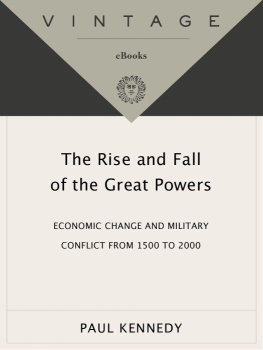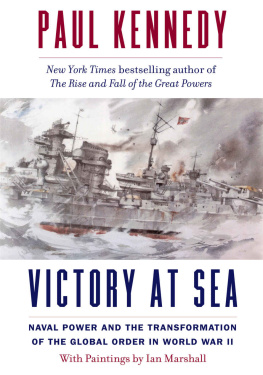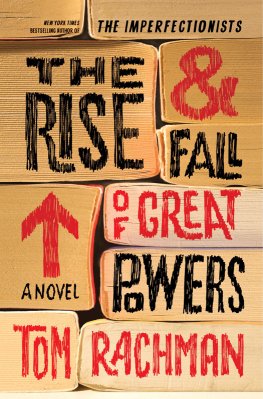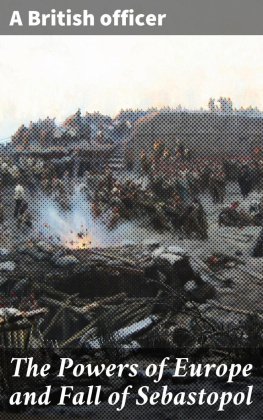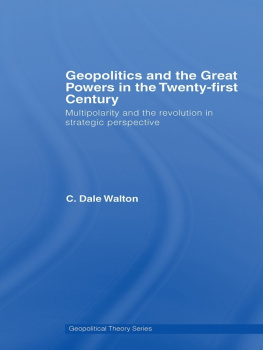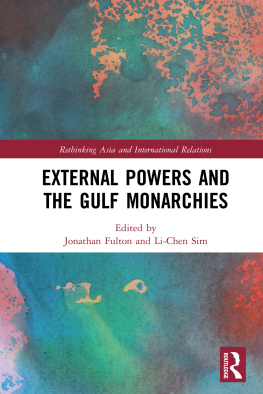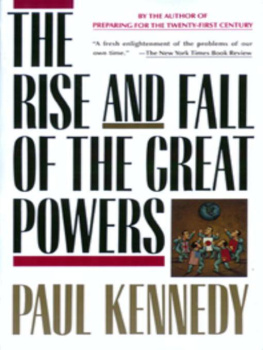Paul Kennedy - The Rise and Fall of the Great Powers
Here you can read online Paul Kennedy - The Rise and Fall of the Great Powers full text of the book (entire story) in english for free. Download pdf and epub, get meaning, cover and reviews about this ebook. year: 1989, publisher: Vintage, genre: Politics. Description of the work, (preface) as well as reviews are available. Best literature library LitArk.com created for fans of good reading and offers a wide selection of genres:
Romance novel
Science fiction
Adventure
Detective
Science
History
Home and family
Prose
Art
Politics
Computer
Non-fiction
Religion
Business
Children
Humor
Choose a favorite category and find really read worthwhile books. Enjoy immersion in the world of imagination, feel the emotions of the characters or learn something new for yourself, make an fascinating discovery.
- Book:The Rise and Fall of the Great Powers
- Author:
- Publisher:Vintage
- Genre:
- Year:1989
- Rating:5 / 5
- Favourites:Add to favourites
- Your mark:
- 100
- 1
- 2
- 3
- 4
- 5
The Rise and Fall of the Great Powers: summary, description and annotation
We offer to read an annotation, description, summary or preface (depends on what the author of the book "The Rise and Fall of the Great Powers" wrote himself). If you haven't found the necessary information about the book — write in the comments, we will try to find it.
The Rise and Fall of the Great Powers — read online for free the complete book (whole text) full work
Below is the text of the book, divided by pages. System saving the place of the last page read, allows you to conveniently read the book "The Rise and Fall of the Great Powers" online for free, without having to search again every time where you left off. Put a bookmark, and you can go to the page where you finished reading at any time.
Font size:
Interval:
Bookmark:

First Vintage Books Edition, January 1989
Copyright 1987 by Paul Kennedy
All rights reserved under International and Pan-American Copyright Conventions. Published in the United States by Random House, Inc., New York. Originally published, in hardcover, by Random House, Inc., in 1987.
Library of Congress Cataloging-in-Publication Data
Kennedy, Paul M., 1945
The rise and fall of the great powers.
1. History, Modern. 2. Economic history.
3. Military history, Modern. 4. ArmamentsEconomic aspects. 5. Balance of power. I. Title.
D210.K46 1989 909.82 88-40123
eISBN: 978-0-307-77356-2
Grateful acknowledgment is made to the following for permission to reprint previously published material:
Lexington Books, D. C. Heath and Company: An illustration from American Defense Annual 19871988, edited by Joseph Kruzel, Copyright 1987, D. C. Heath and Company (Lexington, Mass.: Lexington Books, D. C. Heath and Company). Reprinted by permission of the publisher.
Maps by John Paul Tremblay
v3.1
To Cath
W hatever the weaknesses of this book, they would have been far greater without the kind help of friends. J. R. Jones and Gordon Lee went through the entire manuscript, asking questions all the way. My colleague Jonathan Spence endeavored (I fear with only partial success) to curb the cultural assumptions which emerged in the first two chapters. John Elliott was encouraging about , despite its being very evidently not my period. Paddy OBrien and John Bosher sought to make my comments on eighteenth-century British and French finance a little less crude. Nick Rizopoulos and Michael Mandelbaum not only scrutinized the later chapters, but also invited me to present my ideas at a series of meetings at the Lehrman Institute in New York. Many, many scholars have heard me give papers on subthemes in this book, and have provided references, much-needed criticism, and encouragement.
The libraries and staffs at the universities of East Anglia and Yale were of great assistance. My graduate student Kevin Smith helped me in the search for historical statistics. My son Jim Kennedy prepared the maps. Sheila Klein and Sue McClain came to the rescue with typing and word processing, as did Maarten Pereboom with the bibliography. I am extremely grateful for the sustained support and encouragement which my literary agent, Bruce Hunter, has provided over the years. Jason Epstein has been a firm and patient editor, repeatedly getting me to think of the general readerand also recognizing earlier than the author did how demanding it would be to deal with themes of this magnitude.
My family has provided support and, more important still, light relief. The book is dedicated to my wife, to whom I owe so much.
Paul Kennedy
Hamden, Connecticut, 1986
TABLES
CHARTS
T his is a book about national and international power in the modernthat is, post-Renaissanceperiod. It seeks to trace and to explain how the various Great Powers have risen and fallen, relative to each other, over the five centuries since the formation of the new monarchies of western Europe and the beginnings of the transoceanic, global system of states. Inevitably, it concerns itself a great deal with wars, especially those major, drawn-out conflicts fought by coalitions of Great Powers which had such an impact upon the international order; but it is not strictly a book about military history. It also concerns itself with tracing the changes which have occurred in the global economic balances since 1500; and yet it is not, at least directly, a work of economic history. What it concentrates upon is the interaction between economics and strategy, as each of the leading states in the international system strove to enhance its wealth and its power, to become (or to remain) both rich and strong.
The military conflict referred to in the books subtitle is therefore always examined in the context of economic change. The triumph of any one Great Power in this period, or the collapse of another, has usually been the consequence of lengthy fighting by its armed forces; but it has also been the consequence of the more or less efficient utilization of the states productive economic resources in wartime, and, further in the background, of the way in which that states economy had been rising or falling, relative to the other leading nations, in the decades preceding the actual conflict. For that reason, how a Great Powers position steadily alters in peacetime is as important to this study as how it fights in wartime.
The argument being offered here will receive much more elaborate analysis in the text itself, but can be summarized very briefly:
The relative strengths of the leading nations in world affairs never remain constant, principally because of the uneven rate of growth among different societies and of the technological and organizational breakthroughs which bring a greater advantage to one society than to another. For example, the coming of the long-range gunned sailing ship and the rise of the Atlantic trades after 1500 was not uniformly beneficial to all the states of Europeit boosted some much more than others. In the same way, the later development of steam power and of the coal and metal resources upon which it relied massively increased the relative power of certain nations, and thereby decreased the relative power of others. Once their productive capacity was enhanced, countries would normally find it easier to sustain the burdens of paying for large-scale armaments in peacetime and of maintaining and supplying large armies and fleets in wartime. It sounds crudely mercantilistc to express it this way, but wealth is usually needed to underpin military power, and military power is usually needed to acquire and protect wealth. If, however, too large a proportion of the states resources is diverted from wealth creation and allocated instead to military purposes, then that is likely to lead to a weakening of national power over the longer term. In the same way, if a state overextends itself strategicallyby, say, the conquest of extensive territories or the waging of costly warsit runs the risk that the potential benefits from external expansion may be outweighed by the great expense of it alla dilemma which becomes acute if the nation concerned has entered a period of relative economic decline. The history of the rise and later fall of the leading countries in the Great Power system since the advance of western Europe in the sixteenth centurythat is, of nations such as Spain, the Netherlands, France, the British Empire, and currently the United Statesshows a very significant correlation over the longer term between productive and revenue-raising capacities on the one hand and military strength on the other.
The story of the rise and fall of the Great Powers which is presented in these chapters may be briefly summarized here. The first chapter sets the scene for all that follows by examining the world around 1500 and by analyzing the strengths and weaknesses of each of the power centers of that timeMing China; the Ottoman Empire and its Muslim offshoot in India, the Mogul Empire; Muscovy; Tokugawa Japan; and the cluster of states in west-central Europe. At the beginning of the sixteenth century it was by no means apparent that the last-named region was destined to rise above all the rest. But however imposing and organized some of those oriental empires appeared by comparison with Europe, they all suffered from the consequences of having a centralized authority which insisted upon a uniformity of belief and practice, not only in official state religion but also in such areas as commercial activities and weapons development. The lack of any such supreme authority in Europe and the warlike rivalries among its various kingdoms and city-states stimulated a constant search for military improvements, which interacted fruitfully with the newer technological and commercial advances that were also being thrown up in this competitive, entrepreneurial environment. Possessing fewer obstacles to change, European societies entered into a constantly upward spiral of economic growth and enhanced military effectiveness which, over time, was to carry them ahead of all other regions of the globe.
Font size:
Interval:
Bookmark:
Similar books «The Rise and Fall of the Great Powers»
Look at similar books to The Rise and Fall of the Great Powers. We have selected literature similar in name and meaning in the hope of providing readers with more options to find new, interesting, not yet read works.
Discussion, reviews of the book The Rise and Fall of the Great Powers and just readers' own opinions. Leave your comments, write what you think about the work, its meaning or the main characters. Specify what exactly you liked and what you didn't like, and why you think so.

